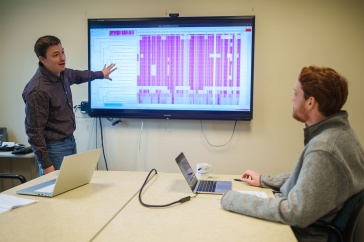A pesky little jellyfish-like animal is causing major problems—and major costs—for aquaculture everywhere by choosing to permanently live on aquafarming equipment, reducing production sustainability. New research from the New Hampshire Agricultural Experiment Station at the University of New Hampshire sheds light on ways to dissuade these animals at early, larval stage from calling aquaculture production systems home.
The research is vital to New Hampshire’s oyster-dominated aquaculture industry, in which the number of farms grew faster than any other state—a 229% increase—from 2013 to 2018, according to the U.S. Census of Aquaculture. The state had nearly $1 million in sales from aquaculture in 2018. Globally, more than 50% of all human-consumed seafood is produced by aquaculture—the farming of fish, mollusks, aquatic plants and other products. The global economic impact of aquaculture is greater than $31 billion.
“In order to get happy and healthy farmed seafood, we need the nets and equipment to function properly,” said Sydney Birch, a doctoral student in molecular and evolutionary systems biology. “The problem is that these jellyfish-like animals are clogging nets and structures, which reduces the waterflow to farmed seafood. This robs the seafood of vital nutrients, which can negatively impact the growth and quality of seafood.”
  |
| A lobster cage covered in Ectopleura, a jellyfish-like animal. (UNH photo) |
A relative of jellyfish, the animals are considered a fouling organism, which means that they aggregate on man-made structures, like barnacles. The larvae use a combination of light, taste and touch information to choose when and where to metamorphose into adults that create the problems. The aquaculture industry estimates that the cost of managing and removing them accounts for as much as 10% of the total production cost of farmed seafood.
“The economic impact to aquaculture of fouling marine species is significant,” said David Plachetzki, associate professor of molecular, cellular, and biomedical sciences. “In Great Bay and in New Castle shellfish fisheries, workers expend much effort removing fouling organisms from culture systems annually. Often, this procedure must be done intermittently throughout the growing season at significant cost.”
Birch combined both genetics and behavioral experiments that tested the effects of different colors of light, chemicals involved in taste, and different surface textures to pinpoint what sensory pathways the larvae are using to identify a good habitat. She found that larvae were least likely to call aquaculture production systems home when there was a surface texture and no biofilm. And it turns out, larvae don’t like red light.
Scientists believe the larvae are exhibiting a phenomenon called Multisensory Integration (MSI), which is occurs when an animal incorporates information from more than one sense and behaves differently as a result. The process has been highly researched in animals with brains, but less research has been done on animals that lack brains like these larvae.
“These results support the behavioral results that we found from the larval settlement study that larva can decipher and respond to all three cues,” said Birch. “This is pretty fascinating since these larvae do not have brains to process all of this information. We think that this could be one of the first examples of a brainless larvae using MSI during the larval settlement decision.”
This material is based upon work supported by the NH Agricultural Experiment Station, through joint funding of the National Institute of Food and Agriculture, U.S. Department of Agriculture, under award number 1013436, and the state of New Hampshire. Additional support was provided by the National Science Foundation.
-
Written By:
Lori Gula '06G | NH Agricultural Experiment Station | lori.gula@unh.edu

















































